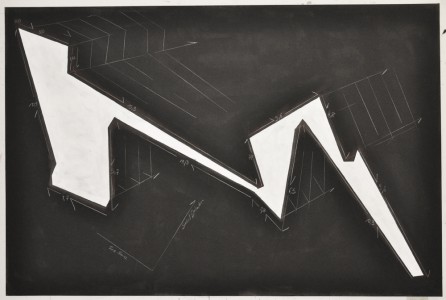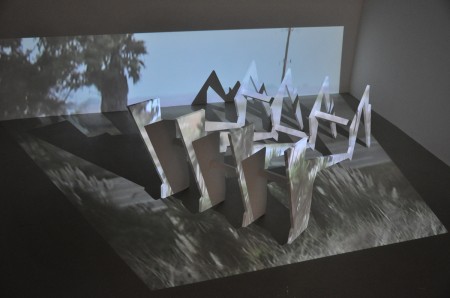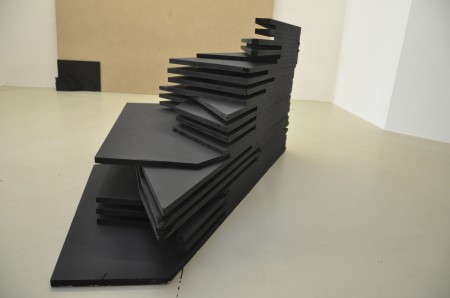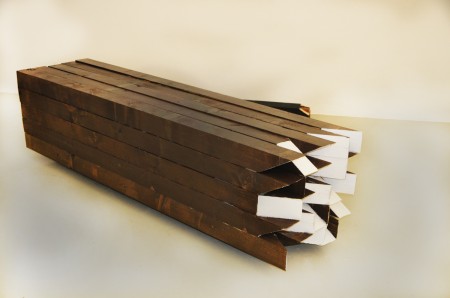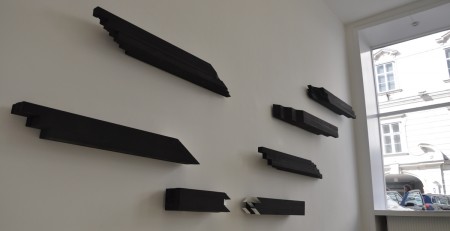Spatial Narratives
.
Archived photographies and maps certify the western part of Los Angeles a moved history. Hollywood and tourism industry established the picture of a desert city. But the area at the Santa Monica Bay was once swampland (“Wetlands”) and pastureland, pulled through from bays and rivers, a habitat for plants and animals, water reservoirs for the inhabitants of the city.
Urban development and geological radical changes constantly transform the conditions of the region. Due to the urban sprawl the largest part of the surface is inaccessible today. The area MacArthur park Lake nearby the airport emphasizes itself like a reminiscence of the past and retained a certain originality. The work “Spatial Distinction“ takes the viewer by means of a fictitious tracking shot into a fragment of this landscape. The movement (track) of the camera describes the shape of the sculpture and it’s surface, which is used as the body and surface of the projection. What the camera reveals, remains incomplete.
The work “Spatial Distinction“ takes the viewer by means of a fictitious tracking shot into a fragment of this landscape. The movement (track) of the camera describes the shape of the sculpture and it’s surface, which is used as the body and surface of the projection. What the camera reveals, remains incomplete. The cavity is not lost, it does not remain untold: the black body marks explicitly the negative of the white body. It is the equivalent opposite, which continues to develope itself further and draws its own conclusion from the fragments of the history “of the Wetlands”. The levels of narration merge together and consolidate themselves to an actual place with open exit.
The same motive is projected in a altered tracking shot on the fissured front of an oblong body “Spatial PlotPoint ” and divided into individual pictures. The projection and it’s narrative thread thereby break in the tapered surfaces of the body, its surfaces show a resemblance according to the format 16:9. The projection is choreographed again and adjusted by the differentiated surface in various speeds and directions due to the movement of the tracking shot.
The narrative structure of the film is divided into versions and fragments of its own. Miniatures of the body, are placed at the walls of the gallery. They play with possibilities deduced from their large counterpart in order to multiply its description.
Text / Julia Herbster
Spatial Distinction Sketch #02
300×200 acrylic on canvas 2014
01: Spatial Distinction
.
02: Negativ Spatial Distinction
.
03: Spatial PlotPoint / without projection…
.models
Archivierte Fotografien und Landkarten attestieren dem westlichen Los Angeles eine bewegte Geschichte. Hollywood und Tourismusbranche haben das Bild einer Wüstenstadt etabliert. Aber die Gegend am Santa Monica Bay war einmal Sumpfland (“Wetlands”) und Weidefläche, durchzogen von Buchten und Flüssen, ein Lebensraum für Pflanzen und Tiere, Wasserspeicher für die Bewohner der Stadt. Stadtplanung und geologische Umbrüche verwandeln konstant die Gegebenheiten der Region. Heute ist der größte Teil der Fläche zersiedelt und verbaut. Wie als Zeugnis des Vergangenen hat sich das unweit des Flughafens gelegene Areal MacArthur Park Lake eine gewisse Ursprünglichkeit bewahrt.
Die Arbeit “Spatial Distinction“ führt den Betrachter mittels einer fiktiven Kamerafahrt durch ein Fragment dieser Landschaft. Der genommene Weg materialisiert sich im Körper – genauer an der Oberfläche der Skulptur, die als Projektionfläche dient. Was uns die Kamera wiedergibt bleibt unvollständig. Doch das Ausgesparte geht nicht verloren, es bleibt nicht ungesagt: der schwarze Körper bezeichnet explizit das Negativ des weißen Körpers. Er ist gleichwertiges Gegenüber, der sich selbst weiter entwirft und seinen eigenen Schluss aus den Fragmenten der Geschichte der “Wetlands” zieht. Die Ebenen der Narration rücken zusammen und verdichten sich zu einem tatsächlichen Ort mit offenem Ausgang.
Das gleiche Motiv wird in einer veränderten Kamerafahrt auf die zerfurchte Vorderseite eines länglichen Körpers geworfen und in einzelne Bilder zerteilt. Das Licht der Projektion und der dabei transportierte Erzählstrang brechen sich in den abgeschrägten Flächen des Körpers, deren jeweiliges Format an 16:9 erinnern. Die Projektion wird durch die differenzierte Oberfläche neu choreografiert, reguliert in diverse Geschwindigkeiten und Laufrichtungen. Das erzählerische Moment des Filmes wird in Versionen und Fragmente seiner Selbst geteilt. Miniaturen des Körpers, die an den Wänden der Galerie platziert sind spielen mögliche Varianten ihres großen Pendants durch und vervielfältigen dessen Schilderung.
Text Julia Herbster
.

